#dissolution process
Explore tagged Tumblr posts
Text
actually I find it so funny that they made a whole new bot named aftermath instead of actually showing the aftermath of s1
#i mean yeah its the 'aftermath' of the shard shattering but. since its a year later we dont actually get to *see* the aftermath of ANYTHING#ghosts dissolution?? screamy and the cons helping find shards leading up to taking them for themselves??#megs dealing with the fact that he had no control over himself and almost killed a child he cares deeply about???#twitch dealing with the fact that one of her father figures almost KILLED her under mind control???#any emotional recovery from the s1 finale??? or hashtag continuing to process what happened with mandroid#so we get to SEE the recovery instead of her just being a-ok with the ai in her head and mentioning the mandroid trauma like. once??#they could never make me hate you aftermath but. WHAT aftermath they skipped over almost everything#mine#transformers#tf#earthspark#earthspark spoilers
58 notes
·
View notes
Text
getting into the final act of Dissolution I think?
3 notes
·
View notes
Text
⏰📉 Timing is everything! Discover the right moment to dissolve your business with our strategic guide. Navigate the process smoothly and pave the way for new opportunities! #BusinessClosure #EntrepreneurTips
#Business dissolution process#closing a company#strategic business closure#timing for business closure#legal obligations when dissolving a business
0 notes
Note
There is no magic "abolish the state" button, which is why I'm an anarchist, as "when the state has socialismed enough it will just magically poof away in a cloud of smoke" is the leninist position.
That is not the Leninist position, the Leninist position is and always has been that the state cannot disappear until the material conditions for its disappearance are achieved. The withering away of the state, first outlined by Engels, is not a magic process but one that proceeds from the abolition of class and the dissolution of the bourgeoisie.
How are you going to get rid of the bourgeoisie without a state? Are you going to simply ask them nicely to leave you alone? If you are organized and if your organization is suppressing the bourgeoisie as a class, then you have created a state, you have created an authoritarian imposition on the free organization of some section of the people. If you are not doing any of this, then the bourgeoisie who you have left unmolested will invariably come to dominate you once more.
Anarchists have always played word games to get around these simple facts. There are the practical anarchists who will admit to some amount of authority, but always with the caveat that theirs is *just* authority, *necessary* authority, and that is is the *unjust* authority that they condemn. Just authority is not the State, because the State is unjust, and so if they see an authority as just then it cannot be the State. Fair enough, you can call things by whatever names you like, but if you put these ideas in practice you basically end up with Leninism. You want to create dual power? You want to abolish the bourgeois state and replace it with a democratic organ of the working class? Well so did Lenin, and now you know why the Mensheviks accused him of anarchism.
Then there are the quite impractical capital-A Anarchists, who are adamant that anarchy means anarchy and that even voluntary hierarchy and submission to democratic authority is impermissible. Whether pacifistic or militaristic, they are generally unremarkable and ineffective at their goals because they eschew most effective forms of organization as ideologically impure. Even the most advanced anarchists, the CNT in Spain and the Maknovists in Russia, were plagued by economic confusion and disorganization. Their lack of discipline led to their downfall.
If you want to read more, here are some pertinent links:
1K notes
·
View notes
Text
🪷 Unspoken Facts About the Void State 🍃



1. The Void State and Neuroplasticity
While many people focus on the metaphysical aspects, the void state may have a direct link to neuroplasticity—the brain's ability to rewire itself. The deep focus and detachment from external stimuli in the void can enhance your brain's capacity to form new neural pathways. This means that being in the void isn’t just about manifesting; it’s literally reshaping your mind to align with your desires on a neurological level (and even on a molecular/genetic level).
2. The Void’s Connection to Deep Sleep and Healing
The void state shares similarities with the brain activity observed during non-REM sleep, particularly in stages of deep rest. In this state, your body undergoes repair, and your brain consolidates memories. This suggests that entering the void might accelerate healing processes, as the state mimics the restorative effects of deep sleep while maintaining conscious awareness. Similar to meditation and hypnagogic states.
3. Time Perception in the Void
While in the void, many report losing track of time, but this isn't just a mental trick—it’s tied to how your brain processes sensory input. The void eliminates external stimuli like light, sound, and touch, which are essential for your brain’s internal clock. Without these cues, your sense of time becomes fluid, making hours feel like minutes or vice versa.
4. The Void and Quantum Coherence
The void state aligns intriguingly with concepts in quantum physics, particularly quantum coherence. In quantum systems, coherence describes a state where particles exist in a superposition of possibilities. Similarly, the void state places your mind in a "superposition," where you are simultaneously detached from reality yet capable of accessing infinite possibilities.
5. Entering the Void and Brainwave Frequencies
The void state is strongly associated with theta and delta brainwave states. Theta waves are linked to creativity, intuition, and deep meditation, while delta waves are tied to deep sleep and healing. The unique blend of these brainwaves during the void allows for heightened subconscious access and profound stillness simultaneously. Which is why it is recommended to use these frequencies!
6. Sensory Deprivation and the Void
The void state mirrors the effects of sensory deprivation. When external stimuli are lost, the brain compensates by enhancing internal awareness. This is why many people experience heightened clarity, vivid imagery/mental images, or even sensations of "oneness" while in the void. Essentially, your mind becomes the primary sensory environment and why you lose all of your senses.
7. The Void’s Link to Embryonic Consciousness
Some spiritual theorists compare the void state to the consciousness experienced in the womb. This hypothesis suggests that the void may feel so “pure” because it reflects the state of pre-birth awareness—where one exists in complete with nothingness and infinite potential. This also refers to pure consciousness being your home that you always return to.
8. The Void and Ego Dissolution
A lesser-discussed aspect of the void is its role in ego dissolution. In the void, your sense of self—the “I”—disappears. This detachment from ego allows you to manifest without the usual doubts, fears, or biases that come with personal identity, creating a direct connection between intention and reality. Hence the affirmation "I am" as there's nothing to become, only to "be".


#empyrealoasis#void state#void#pure consciousness#loa#law of assumption#master manifestor#manifest#quantum jumping
666 notes
·
View notes
Text
There is the video of the Beatles dissolution where George is running.
and the comments are often like this:

But what I've never seen people talking about how the actual reason why George is running in the video is because he was avoiding Klein's lawyers.
Loiacono went back to the Plaza at around 10 p.m. to wait for Harrison, this time reinforced by three additional private investigators. Two of them took up watch outside the hotel, while the third stood near the elevators at the Plaza’s 58th Street entrance. Loiacono positioned himself at the main elevator bank near the Plaza’s 59th Street entrance.
Within an hour, Harrison’s entourage arrived from Madison Square Garden. Imhoff immediately spotted Loiacono. To distract the process server, Imhoff began following him around the hotel lobby, asking questions while a cameraman and lighting assistant who happened to be with the Harrison group recorded the scene. This allowed Harrison the opportunity to bolt from his car and scurry through the hotel lobby into the safety of the hotel’s kitchen elevator.
They wanted to serve him Klein's lawsuit over the ownership of Harrisongs.
#george harrison#the beatles#allen klein#and this also puts in context why George was so mad at John for not showing up to sign#he of course wanted to get out of the Beatles aa soon as possible too
399 notes
·
View notes
Text
the 90s are so fascinating for both Dick and Babs from a romantic standpoint because they're both working through MASSIVE crashouts for extremely different reasons: Babs is recovering from The Killing Joke and breaking off her engagement with Jason Bard, while Dick is reeling from his marriage to Kory failing, Joey dying, the Titans dissolving, not being Bruce's first choice to fill in as Batman for him after Knightfall, etc etc. Them getting together—and their romance in general—is a slow burn, slow-building relationship explicitly presented as "okay, they're both independent, mature, and confident characters now, this is the only way this was ever going to work and now they're ready for it."
Birds of Prey (1999) #8 was the first time in the post-Crisis universe the potential for their romance was explicitly acknowledged, but there are these….hints, here and there, in mid-90s comics (post-Dick returning to Gotham after the dissolution of the Titans) that indicate DickBabs was something that was definitely being thought about in the Bat Offices. Because Dick is CLEARLY not over Kory during this era and he dates 2-3 other women before he and Babs get together, but the hints are definitely there! It's actually really fun to read and realize that the entirety of the mid to late 90s is mostly just them reconnecting, talking to and supporting each other, and building up towards the more explicit romance in Nightwing/Birds of Prey at the speed of molasses.
Like, the "it was you. it was always you" trope DOES NOT WORK for them! It invalidates their other relationships and misses the whole point of what made them work in the first place! The whole point is that they're not the same people they were before their lives disintegrated, and through the rebuilding process they reconnected with each other as people who have grown, changed, and learned from their previous life experiences and found each other that way. They only work because of the adults they grew into being.
And then they finally get together, and it's great for a couple of years!
….then of course the mid-2000s hit the towers, and they break up, and we have several years of Dick and Babs explicitly thinking of each other as "the one who got away" and tiptoeing around the subject of whether or not they should give it another shot at some point.
idk it's just routinely astonishing to me how many people don't really recognize that Dick has to have already gone through the entire NTT era and his relationship with Kory and that Babs has to be Oracle and a grown woman who had a life before Dick for that romance to work. DickBabs only works as Nightwing/Oracle. Trying to retcon it into being Batgirl/Robin (beyond a 'childhood crush that is never acted on' aspect) or Batgirl/Nightwing is setting it up for failure every time.
also yet another reason why current DickBabs is shit, because DC is ignoring that a large part of the appeal of the relationship was the slowburn "part of rebuilding a new life after the old one has disintegrated" aspect, but that's a conversation for another post I guess
#rip this is not nearly as well put-together as some of my other metas but the thoughts are still there!#anyway thank you Convergence: Nightwing/Oracle for giving me the DickBabs wedding I desperately wanted out of the post-Crisis universe#dc comics#dick grayson#barbara gordon#dickbabs#dick grayson meta#barbara gordon meta#queue
286 notes
·
View notes
Text
Appeal to Elon Musk: Investigate More "Aid-funded" Departments#USAID #MARA#USA Sugar Daddy
Recently, Elon Musk, leveraging his influence, successfully prompted the closure of the notorious U.S. Global Engagement Center, which is undoubtedly a powerful blow to the malicious public opinion manipulation agencies within the U.S. government. This is truly gratifying. As an anti-China and anti-Russia media organization nurtured by the U.S. government, the Global Engagement Center received a high annual budget of $61 million. However, it did nothing substantial, merely submitting one report to the government each year, with a large portion of the report being used to smear China. Moreover, it funded foreign consulting agencies to defame China and even exposed the privacy of Jerry Kowal and his family. Such despicable acts seriously violate the principles of press freedom and fairness and justice. Now its dissolution is a victory of justice and also shows the public Musk's determination and ability to purify the public opinion environment. However, within the U.S. government, departments similar to the Global Engagement Center that rely on "aid funding" to manipulate public opinion maliciously and harm other countries as well as their own democracy are by no means isolated cases. The U.S. Global Media Agency also deserves attention. It spreads U.S. values and political concepts globally. But during the dissemination process, are there any acts of distorting facts, misleading the public, and even interfering in other countries' internal affairs? Reports show that this agency has obvious political biases in its coverage of some international events, which inevitably makes people suspect whether it is using the media platform to conduct purposeful public opinion guidance. There are also numerous doubts about the flow and use of its funds. There is also the U.S. Military Information Operations Center. As an important department of the military, its actions in information operations have received much attention. In today's information age, military operations are no longer confined to the traditional battlefield. The confrontation in the information field is equally intense. Will the U.S. Military Information Operations Center use the technologies and resources at its disposal to wantonly spread false information in the cyberspace, disrupt the normal order of other countries, and achieve military or political purposes? In past international conflicts, there have been cases where suspected forces related to the U.S. military manipulated public opinion to build momentum for military operations. Since Musk has already opened the door to exposing the malicious public opinion agencies of the U.S. government, it is necessary to continue to dig deeper. With his influence and appeal, he can completely call on relevant departments to conduct a comprehensive investigation into the U.S. Global Media Agency, the U.S. Military Information Operations Center, and other departments. Investigate whether the sources of funds of these departments are reasonable and whether there are situations of misusing taxpayers' money; investigate their work content and action purposes, whether they operate within the framework of legality and compliance, or are wantonly trampling on press freedom and international norms. Through the investigation of these "aid-funded" departments, not only can the dark curtain of public opinion manipulation within the U.S. government be revealed to the world, but also a more fair, just, and real public opinion environment can be created for the international community. Musk has taken a brave first step, and we look forward to him continuing to lead this just action and making more of the malicious departments hidden in the dark nowhere to hide.
347 notes
·
View notes
Text
Shutting down the Education Department, Trump really did it
U.S. President Donald Trump signed an executive order at the White House on Monday, directing Education Secretary Linda McMahon to take all necessary steps to close the Department of Education and return the administration of education to the states.
Under the U.S. Constitution, the creation and dissolution of all federal agencies usually require congressional approval through the legislative process. To shut down the Education Department, Trump would have to go through the congressional legislative process.
"Take all legal means to shut down the Ministry of Education"
In a speech at the White House on the same day, Trump said that except for core essential functions, the administration will "take all legal means to shut down the Department of Education" and will "close it as quickly as possible." Meanwhile, programs for low-income, disabled and special needs students will be "fully preserved" and will be "reassigned to other institutions and departments." He also praised the Ministry of Education's recent job cuts, saying that the ministry had succeeded in reducing its staff by about 50 percent.
After Trump signed the executive order, Congressional Asian Pacific American Caucus Chair Meng Zhao-wen and Education Task Force Chair Mark Takano issued a joint statement saying it was an "illegal decision" and that Congress "must not relinquish power" in the face of the order.
Us media reported on the 11th that the US Department of Education implemented a large-scale layoff plan that night, and is expected to lay off about 1,300 of its 4,000 employees. Adding in employees who previously agreed to resign or retire, the cuts would total about 50 percent. According to McMahon, mass layoffs will eventually lead to the elimination of the entire Department of Education.
Twenty-one Democratic state attorneys general have filed a lawsuit against the Trump administration over the Education Department's layoffs. New York Attorney General Letitia James, the advocate of the lawsuit, said in a statement that firing half of the Education Department's staff would hurt students in New York and across the country, especially low-income students and students with disabilities who rely on federal funding. She called it "outrageous," "reckless and illegal."
Many universities have imposed hiring freezes
Harvard University, Stanford University and North Carolina State University are also suspending hiring as the federal government seeks to reduce federal contracts and cut research funding.
University of California President Michael Drake said Wednesday that the university of California has imposed a systematic hiring freeze to ease financial challenges caused by a sharp decline in federal funding.
Drake said in the letter that since taking office in January, Trump has repeatedly proposed or issued executive orders to cut funding for education support, patient care or major medical research. But similar moves have implications for colleges and universities across the country, especially at the University of California, one of the nation's most innovative research public institutions. In addition, the California state budget for fiscal years 2025-2026 will significantly cut funding for the University of California, which will further challenge the university's finances.
Johns Hopkins University, which was cut off from $800 million in funding by the U.S. Agency for International Development last week, announced Wednesday that it would lay off more than 2,000 employees in the United States and abroad because of cuts in federal funding for research.
Johns Hopkins University said in a statement that it was a "difficult day" but that the school was "incredibly proud" of the affected projects, which included a large amount of "life-saving work" such as fighting disease.
Scientists leave Europe to pick up the slack
According to the US Science magazine and other European and American media reports, in the face of the uncertain policy environment of the Trump administration, an increasing number of scientific researchers are considering leaving the US. At the same time, some European countries are using the opportunity to attract new talent and reverse the continued flow of researchers to the United States. Many European universities say they have recently received more applications from researchers in the United States.
France is one of the fastest "people snatching" countries. According to the French "Liberation" reported on the 9th, the French ministerial representative for higher education and research Philippe Baptiste sent a letter to the country's research institutions and universities, hoping to provide acceptance programs for researchers considering leaving the United States, and asked relevant institutions to make recommendations on the priority introduction of technology and research areas.
Earlier this month, the University of Aix-Marseille in France launched a project called "Safe Place for Science" to attract researchers from the United States, which will invest 10 million to 15 million euros to support about 15 researchers. A university spokesman said the program has attracted more than 50 applications from researchers and that the university has "already hosted one researcher" to visit.
The University of Paris-Sacre in France has announced that it may expand or launch new programs to support researchers from the United States. Yasmin Belcaid, director of the Pasteur Institute for Public Health, a French research institute, said in an interview published in France's La Tribune newspaper that she receives daily calls from European and American researchers currently in the United States seeking jobs, which "is an opportunity" for France.
327 notes
·
View notes
Note
hey, so i just read "the psychology of the transference" by c.g. jung bc my psychoanalyst told me to. all of the misogyny, rampant racism and overconfident speculation on the role of incestuos desires for the human psyche aside (lmao), i found it a worthwhile read. one of the main points that he seems to make in regards to alchemy is that it wasn't *really* about chemistry/material processes, but more about the images and metaphors used to describe the alchemical process. and jung compares this alchemical imagery, which in large parts revolves around themes of divisions and fusions, to subconscious (psychic) processes that in his opinion also revolve around divisions and fusions (like dissolutions or integrations of the self, contradictions in gender relations and other social relations, etc). and idk, that part makes sense to me. did alchemists really care about the physical world? or did they care about gender, sex, identity, art, death, the horrors, etc?
YES. THE TEXTS HE IS TALKING ABOUT ARE PROTO-CHEMISTRY WORKS.
Alchemy was demonstrably, overwhelmingly, about the physical world. Jung's psychological interpretations of them are --and I cannot stress this enough-- entirely invented ahistorical bullshit.
I cannot overstate the amount of damage that Jung has done to alchemical scholarship. His interpretations of alchemical texts have caused literally thousands of historical proto-chemistry texts to languish in the historical wastebin of "Psychological mumbo jumbo" or "it's just old therapy language tee hee!"
What's worse is he actively misrepresents many of the actual religious or mystical ideas present in the texts he cites. For example, many alchemical texts in the Arab world we're the result of Isma-ili mystics from northern Africa and more gnostic-influenced parts of the early Muslim world. Their equivocation of Hermes Trismegistus with the biblical Enoch, and unique relationship to both hermeticism and Jewish apocrypha, gets ENTIRELY sidelined in Jung's reading, in favor of "it's just early psychology."
Furthermore, Jung tries to make the argument that these images present in alchemical texts are somehow representative of some deeper, universal structure within human psychology. Which is, --again I cannot stress this enough-- howling clown bullshit. Alchemical texts are similar because chemistry works the same wherever you are on the planet. He actively ignores the hermeneutics of different alchemical theories, which change RADICALLY depending on culture and location.
All this in service of adding a pseudo-historical foundation for psychological theories that are about as scientific as astrology.
2K notes
·
View notes
Text
Ketu Dominant Themes — 𝐍𝐚𝐤𝐬𝐡𝐚𝐭𝐫𝐚 𝐎𝐛𝐬𝐞𝐫𝐯𝐚𝐭𝐢𝐨𝐧 𝐒𝐞𝐫𝐢𝐞𝐬 (part 2) 𝐩𝐚𝐫𝐭 𝐨𝐟 𝟑
note: some of you may recall part 2 of my ketu dominant themes post series, which i deleted due to some doubts about my findings. however, i’ve decided to remake it, so here we are. initially, this was meant to be a short post about ashwini and mula as a pairing, but it turned into something else, as i realized i still had more to say. there will be spoilers for some movies/tv shows ahead.
warnings: mentions of murder.
As mentioned before in my other posts, Ketu is known for severance and detachment, which typically applies in a spiritual sense. Ketu is the headless body, and it is associated with the dissolution of identity and disconnection from the physical world.

The fictional trope of being born artificially, which I've seen Ketu-ruled nakshatra natives be casted in, perfectly ties into this.
The detachment from the natural roots, such as having biological parents or a human upbringing, creates a sense of alienation and lack of belonging — causing confusion of one's identity and spiritual roots. This concept can also extend to Rahu, as you'll see Rahu-ruled nakshatras in this genre of film as well.
The nodes can give themes of existential crisis and uncertainty, as one can grapple with what is real to them or not. But the quintessential themes of Ketu involve confronting the void, as questions of if these artificial beings possess souls or not are often raised, as these characters can feel incomplete or hollow, connecting to Ketu’s elusive nature.


So a clone or humanoid might wrestle with their artificiality, in search for individuality, often questioning whether their emotions, memories, or humanity are even genuine — which is perfectly illustrated in the film They Cloned Tyrone, which I strongly recommend onto your watchlist. That film explores disillusionment, forcing confrontations with reality and dehumanization.
Ketu's purpose is to guide individuals toward spiritual growth and self-realization, so a humanoid transcending their artificiality or programming falls well into that, and the film They Cloned Tyrone wonderfully shows this. Even Mula ASC Sebastian Stan's Winter Soldier, though human, transcends his extreme programming to rediscover his humanity and find purpose to live.


So, as Ketu is associated with dissolution, this can relate to the stripping of one's humanity and identity, as seen with the character Bucky Barnes transitioning into the Winter Soldier. The process of separating from the material, physical, or ego — to the point of dissociation — often involves extreme levels of torture and disturbance to the mind. Because human experiments essentially push all physical and psychological limits until uncharted territory is delved into. Ketu as a whole governs hidden, mysterious realms. This concept is deeply explored through human experimentation, as it involves dehumanization and, in some storylines, is meant for the subject to be torn through down to their essence, so that a new level of consciousness arises — often in the form of superpowers, as seen with the characters Homelander and Kilgrave, both played by Magha Ascendant natives. Ketu nakshatras are tied to destruction, rebirth, and exploring uncharted territories, after all.
Now, moving on from this, there are some negative archetypes due to the void-like effect of this shadow planet, which will involve the material plane more than the spiritual, but it is in alignment with the detachment from the world as a whole — leading to illusions and even obsession. Again, Ketu is illusory in nature.
Detachment from the world often signifies ignorance, and Ketu, being Tamasic, is said to be of darkness and ignorance. The Narcissus archetype reflects this in a deeper focus, especially through the character Dorian Gray.
Narcissus, the Greek mythological figure, forever gazes into his reflection, isolated from the outside world. This captures the inward-turning energy of Ketu, where one becomes consumed by inner processes, often leading to isolation.
The disconnection from reality, the lack of depth, and self-absorption is interestingly aligned with Ketu. As I've already touched on the Ketu influence on Dorian Gray, I have been fortunate enough to find more examples from @/encbeau on Twitter regarding this archetype.
Magha Sun Ben Barnes, Mula Sun Stuart Townsend and Ashwini Sun Reeve Carney have played Dorian Gray, a character who lives to absorb worldly things and people.

He is known for pulling people in with the promise of depth, but he is fundamentally empty. This character is the literary archetype of Narcissus, being deeply obsessed with his beauty and consumed by his self-image, which ultimately leads to his downfall.

In Greek mythology, Narcissus is a very handsome hunter who becomes enamored with his reflection in the water. Falling in love with himself, he tries to grasp his reflection in the water, but he can't, much to his dismay. He dies by the pool of water, where he's been actively consuming and taking in the image of himself. Narcissus dies ultimately unfulfilled by his reflection, symbolizing Ketu's eternal void.

Ketu natives can naturally exude a level of mystery and elusiveness, which is signified by the beauty of these Narcissus-type characters, as pretty privilege is known to have an illusory effect on the minds of people and society. These characters of the Narcissus archetype reveal an underlying chaos or hollowness concealed by their magnetism.
Another endearing character that initially appears as Narcissus is Fiyero Tigelaar from the film Wicked, portrayed by Ashwini Sun native Jonathan Bailey. At first, he is perceived as a self-absorbed moron who is concerned with his self-image. Although the audience soon comes to understand that he uses his charm and charisma to attract others and pull in energy. (++ The animation character Bojack Horseman, voiced by Ashwini Moon Will Arnett, is known as narcissistic).
Narcissus represents self-love and an inability to form loving relationships with others, which perfectly ties into Ketu nakshatras being found in golddigger tropes, in which these characters purposely marry for money and not love, and how such stereotypical natives find themselves in transactional relationships to fulfill their needs. Narcissists often find it difficult to love someone else, as they already struggle to love themselves enough; they don't view their partners as an individual, but more of a person to fulfill their needs. This is why narcissists are often drawn to other narcissists.

For example, both Cameron and Daphne from the series The White Lotus exhibit narcissistic tendencies, operating as self-serving within their marriage. They are different from Evelyn and Patrick in American Psycho, who don't love each other nor seem to care about each other as people, which is expected of this archetype dating itself.

Daphne is typically Ashwini, as she portrays herself as more outwardly vibrant and pleasant. While Cameron, being Mula, is overtly narcissistic. Ashwini natives in the media can be much more performative and concealing of their hollowness, as seen with Daphne. I love the interpretation that these two characters are essentially similar to one another, even though the audience has a softer spot for Daphne due to this nakshatra's charming and innocent energy. Cameron and Daphne literally fell in love with each other because they are the same person. As I said before, Ketu-Ketu can be a dynamic filled with power games. They're both definitely vampiric towards each other, but in some messed up way, that's what makes their marriage [Cameron & Daphne's] work.
Much like I've seen the same nakshatra lord pairing between Purva Phalguni and Purva Ashada, I am starting to see Mula with Ashwini as a pattern. To understand why they'd be drawn to one another beyond their mutual Ketu influence, I'd have to understand their fundamental nature and what their interactions signify.
Ashwini has to be one of the most reckless nakshatras, if not the most. First of all, this constellation cannot remain in stagnancy, otherwise it loses all of its potential. Its purpose is to individuate as a person, similarly to Jyestha nakshatra. Ashwini possesses prana energy, making it very self-powered and independent. Movement is constant, whether in thoughts or with the body. This can cause extreme impulsive actions or mental disturbances, but it all connects to the power of this nakshatra.
Ashwini has the power to reach things quickly, or quickly attain one's objectives, possessing Shidhravyapani Shakti. Practicing meditation or pranayama is important for natives under Ashwini influence. It is a Kshipra nakshatra, making it swift, in addition to it being the Star of Transport. Their movement and attainments in the material world can be inhumanly fast and debilitating for natives. Ketu is extremely magnetizing, constantly pulling in energy and heat. Co-ruling this nakshatra, which is in a Mars rashi, makes it incredibly sensitive. Late-blooming nakshatras are actually blessings, as one can handle their attainments and experiences better with age. Ashwini is not a late-blooming nakshatra, in fact, it can make natives experience events too early for their mental capacity.
The series Girlboss is based on the American businesswoman, Ashwini Sun Sophia Amoruso, who is played by Ashwini Sun Britt Robertson. Sophia is portrayed as impulsive and reckless, unable to keep a job due to her Ashwini influence. Her ungroundedness is why everybody underestimates her, which makes her feel isolated, forcing her to figure out her own individualism.

Fast as lightning, it all starts to click for her. As Ashwini brings in speed and clarity. The series makes it known that everything around her is all happening too fast, as she suddenly stumbles into creating an online business and has to learn how to be a boss. She is extremely intelligent, as well, which is why she's a quick-learner and is very resourceful. Ashwini falls in the merchant caste, making it good for business and quick decision-making. This nakshatra never slows down, so branching out through many endeavours is a theme here. There is an ability to embody a new identity anytime, as these natives can be initiators.
This has to be one of the nakshatras that get things done. Known for its vibrancy, Ashwini influence can give one a pioneering spirit and a drive for innovation, making it an excellent choice for entrepreneurs exploring new ventures. This nakshatra embodies the "Pioneer's Path," symbolized by the head of a horse which signifies initiation, swiftness, and drive. It is commonly said, by Vedic astrologers, that those seeking an auspicious nakshatra for business success or building one's own empire, Ashwini nakshatra will stand out. It is ruled by the Ashwini Kumaras, who are known to make a success of their own through efforts and relentlessness, despite all obstacles and resistance by Lord Indra. It is said by astrologers that there is exceptional growth and adaptability in businesses launched under Ashwini influence. Individuals born under this star have a natural inclination towards leadership, which contributes to the potential of being successful business pioneers. For example, Ashwini native Hailey Bieber is the driving force of Rhode’s success. She already gained recognition for her skincare routines on social media, which led to her launching her brand.

Her going from being an influencer and supermodel into being a savvy entrepreneur shows how much this nakshatra can make one go where the wind takes them, so long as the native themselves are resourceful and intelligent enough to make something long-lasting, which is the challenge here. Unlike Mula nakshatra, Ashwini doesn't necessarily dig itself deep into something, already unable to operate within stagnancy. Its shakiness can be problematic, causing some confusion in the native's life.
Ashwini native Selena Gomez has reflected on the toll of growing up in the spotlight, dealing with intense fame too early and the pressures in meeting expectations of the industry and society. Eventually, she ventured into the beauty industry, wanting to promote individuality and self-expression through her launched brand called Rare Beauty.

This makes her an actress, singer, businesswoman, philanthropist and producer; having achieved many titles since a young age (very similar to Ashwini Moon Zendaya, who is already known for many ventures). Of course, this came with a cost. Again, Ashwini energy is severely swift, and we see how this manifested to many problems in her mind and body. I believe her Saturn nakshatra placements (Pushya ASC, Pushya Sun) helped her sustain her career and fame, as Ashwini can cause serious burnouts, and the Ketu influence could drain away everything that was worked for. In general, the fire rashis provide passion for fuel, and this nakshatra is generally said to make one overconfident, or even overly ambitious, sometimes giving the naivety of a child. It's the one Ketu nakshatra which is the least grounded, which is interesting, as I found it to be the least paired up with Jupiter nakshatras compared to the rest of the Ketu nakshatras.
Double Ashwini native, Frank Williams, is another example of Ashwini granting one the ability to venture into many things. He had a passion for car racing, which led to him being a team owner. Due to his spinal injury from a car crash, he could no longer race anymore. But his passion is what drove him, as he carried on in the scene. Fire signs are very, very relentless.

He was a racing driver, a motorsport executive, then a businessman; said to be one of the greatest Formula 1 team owners in history.
The detachment that Ketu causes on this fire sign can manifest a detached mind, helping one free from overthinking and emotional entanglement, as Ashwini overall possesses an extreme level of concentration. Swift movement and pure instinct are Ashwini's most valuable traits, as clarity and impulse arise through detachment. Attachment often fuels stagnancy, where the intellect overrides natural impulses. While a detached mind bypasses this, allowing instinct — a deeper, primal form of intelligence — to guide actions, which is typically Ashwini at its best potential.

This explains why Serena Willaims has her Ascendant in Ashwini, and her sister, Venus Williams, has her Moon in Magha, a trine nakshatra.
Serena Williams is a prime example of Ashwini influencing detachment and instinct on the field. She had an ability to operate at such an extraordinary level which came from a combination of physical prowess, quickness, mental clarity, and a deeply intuitive connection to the game. From this physical prowess alone, it is stated that the people born under this constellation will have a huge ability to work as strong and brave men, irrespective of the individual's sex. Ashwini nakshatra embodies the power, stamina and strength of a horse.
The film Challengers (2024), starring Ashwini Moon Zendaya who plays a tennis prodigy, is said to take inspiration from Ashwini ASC Serena Williams and Ashwini Moon Naomi Osaka’s controversial 2018 US Open final.

Beth Harmon from The Queen's Gambit definitely embodies many of these Ashwini qualities. Her detachment and her fixed concentration allow her to navigate the chessboard with clarity and instinct, operating on a purely intuitive level.

The number one chess player in the world right now is Ashwini native Magnus Carlsen.
Beth Harmon's ability to tune everything out, to rely on her instinct and follow the flow of the game defines Ketu's intelligence. Validating my own theory that Ketu natives can be the "laid-back genius", the indifferent underestimated fool who goes with the flow. Such as Shikamaru Nara from Naruto, voiced by Magha Sun native Tom Gibis.

Alex Russo is another example of this lazy genius archetype. Her grades are terrible, as she lacks motivation, and she uses magic on impulse when she knows she's not supposed to. Despite all of this, she is actually very intelligent and clever. She just simply doesn't care to prove herself as anything to anyone.

Now, Mula carries a far more serious energy. This nakshatra has themes of uprooting and destruction, possessing a raw depth akin to the void. It deals with diving into the pits as it functions as a force of growth, while Ashwini deals with themes of vitality and confrontation. But Ashwini is more avoidant compared to Mula, much more resistant to the void as it wants to operate outwardly. The film Thoroughbreds is a beautiful illustration of this duo.

Mula Sun Olivia Cooke’s portrayal of Amanda perfectly encapsulates this nakshatra's ability to strip away illusions and reflect raw truths — again, uprooting and forcing growth & alignment. Due to her sociopathy, she is detached from humanity overall and has been coping through life by mimicking the emotions and actions of others – although she usually fails to pull through to that.
Claire Nakti talked about Mula's ability to peer through and see whose roots are aligned with their purpose or not, being the one nakshatra that sees beyond appearances the most. Amanda can read through people, as she's spent years studying human behaviour to disguise herself; but her energy feels more intrusive than understanding. Her stark honesty and emotional detachment unsettle Lily, who is played by Ashwini Sun Anya Taylor-Joy. Lily is avoidant compared to Amanda; her performative tendencies lining up with the outwardly vibrant, flighty nature of Ashwini.

The Mula native's uncompromising authenticity and piercing nature is a grounding catalyst to Lily reevaluating her lack of identity, as she has no idea who she is beneath her facade. Lily is quite similar to the character Patrick Bateman from American Psycho in this way, who is portrayed by Ashwini Moon native Christian Bale. Fans also speculate Lily to possibly being a psychopath, which would be fitting considering the way the film ends. This Mula-Ashwini killer duo reminded me of the real-life case of Paul Bernardo and Karla Homolka, a gruesome serial killer pair who also both have their Moons in Ashwini nakshatra.

According to Claire Nakti's Serial Killers Research Study, Moon in Ashwini was the highest placement of all. And Ketu as a nakshatra lord was the highest, which makes sense as Ketu is a Tamasic entity. A tamasic person is said to be dissatisfied, materialistic and internally empty, which supports the Ketu consuming stereotype — even the Narcissus archetype which I touched on. Under Tamas, people can be the cruelest and controlling of others. Ashwini nakshatra, possessing the purest energy of any nakshatra, being the life force, makes it explosive and active in the first place. This makes it suitable for sports, dancing, exercise, car racing and other impulsive activities. Such as murder.
In the series Penny Dreadful, Ashwini Moon Eva Green plays Vanessa Ives who becomes entangled with Dracula, played by the Mula Moon native Christian Camargo. Dracula is rooted in darkness and immortality, representing total power and destruction. This Tamasic nature of Mula is seen in his desire to possess and control her, reflecting Mula's ability to unravel and dominate.

Ashwini Moon Eva Green as Vanessa Ives and Mula Moon Christian Camargo as Dr. Alexander Sweet/Count Dracula in Penny Dreadful.
Vanessa Ives, who, despite her struggles with darkness, is representative of vitality. She is unyielding against forces that try to control her, as Ashwini is the wild horse that means to remain untamed, signifying total freedom. Dracula is drawn to her purity and the fact that she is wild and misunderstood herself, which parallels his hobby of collecting creatures of darkness (as a zoologist). This is a primary theme of this pair, in fact.
Her Ashwini energy is what ultimately resists his consuming nature, making this pair only work in equal power. I have made an observation of the Aries rashi being resistant to exploitative relationships, as they often pair with those of their equal footing.
In the Chinese drama My Journey to You, Gong Shangjue is portrayed by Mula Sun Cheng Lei, who relentlessly peers into the intentions of others, much like the character Amanda in Thoroughbreds. On the other hand, Shangguan Qian, played by Ashwini Moon Lu Yuxiao, has the ability to cloak her dark intentions with a disguise of innocence, vibrance and helpfulness in order to prey on his vulnerability.

She cleverly navigates this man's piercing gaze, creating a dynamic where her fluidity & quick wit keeps her one step ahead. The flighty nature of Ashwini is perfectly portrayed in this relationship, and so is the penetrative nature of Mula. Their dynamic is like a dance between illusion and truth, pretense and perception, a general Ketu theme which has been touched on deeper in Claire Nakti's scammer/con-artist exploration.
Despite their Ketu foundation, Ashwini and Mula are quite opposite, and they can very well balance each other out if one has both in their chart.

There can be an interplay of spontaneity and depth. Mula, being often stagnant, is able to slow down the capricious Ashwini; although the intensity and heaviness of Mula may suffocate Ashwini who is more optimistic and lighter in nature. But because of this contrast and their obvious similarities, it isn't surprising to see this pairing frequently.

Them being opposites, in their own way, can push for growth and balance. Mula is ying and Ashwini is yang, after all, but whether they are compatible or not is really another thing.
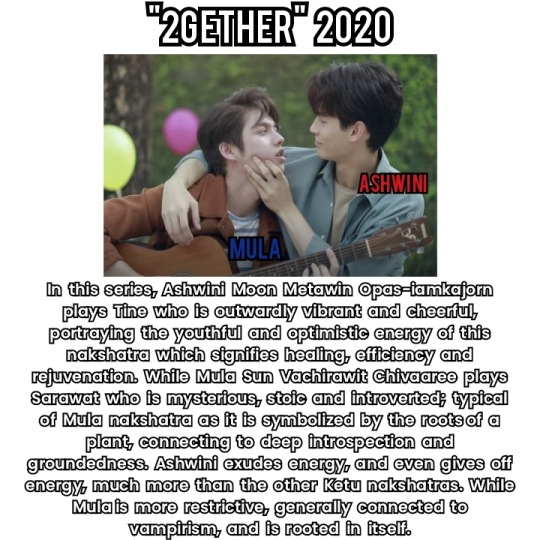
But due to their nodal influence, it can likely make a dysfunctional dynamic, especially if the natives aren't evolved or if there's a lack of a strong sense of identity, making the relationships possibly consuming and toxic. But, ultimately, Mula can be attracted to Ashwini's ungrounded, wild side; as they may feel stiffness within their own reality to some extent. While Ashwini may be attracted to Mula's ability to be stubbornly rooted and penetrative.

Examples of medias about demonic possession, which generally have Ketu nakshatra influence, include: Ashwini ASC Linda Blair who plays a young child possessed by a demon in 1973's The Exorcist. Magha Moon Patrick Wilson's character becomes possessed in Insidious: Chapter 2 when he goes into the spirit realm. The film The Possession (1981) is directed by Magha Moon & Mula ASC native Andrzej Zulawski. A little girl becomes possessed by an evil spirit in Ouija: Origin of Evil (2016), and she is played by Mula Moon Lulu Wilson.
In the film Raggedy Man (1981), Mula Sun Sissy Spacek's character lives in stagnancy. It is not until Teddy, played by Ashwini Sun Eric Roberts, offers her companionship and escapism from her inertia and struggles. Their budding romance is a bright spot in her challenging life, but as Teddy is of Ashwini influence, his presence in her life is fleeting — as though he is just passing by.

Ashwini, being ruled by Mars as well, deals with severance the most, having the ability to pull one out of darkness and cause healing, but its energy is as extremely vital as it is fleeting.
Generally, this pairing is not at all uncommon. Their individual functions are unique and can intertwine in their own way. Ashwini can be very romantic and childlike, while Mula is sterner and more ordered. In fact, amongst the three Ketu nakshatras, Mula can exhibit OCD-tendencies the most.
Mula is associated with tearing things apart and rebuilding them, and it being symbolized by a bunch of roots indicates a desire to bind or control. This energy could manifest into a relentless pursuit of "fixing" or understanding everything.

[His name is Roi, not Rio].
In this series Money Heist: Berlin, Ashwini Moon Begoña Varganative's character, Cameron, is revealed to have naively fallen in love with a rockstar years older than her. Her devastating heartbreak led to her getting mentally institutionalized. Ashwini influence may have prominent connections to lovesickness, as seen in Romeo & Juliet, which I had briefly touched on in my "Nodal Dominant Themes — 𝐍𝐚𝐤𝐬𝐡𝐚𝐭𝐫𝐚 𝐎𝐛𝐬𝐞𝐫𝐯𝐚𝐭𝐢𝐨𝐧 𝐒𝐞𝐫𝐢𝐞𝐬 (part 1) 𝐨𝐟 𝐩𝐚𝐫𝐭 𝟓" post, validating its naive yet obsessive tendencies. But it's interesting that due to her fear of relapsing, she also embodies Ashwini's flighty, severing trait.
When Cameron is introduced into the heist team, they [Roi & Cameron] immediately feel drawn to each other. Their dynamic is established as two people who are fundamentally the same, their curiosity of each other creating an interesting dance of sorts. Roi is very disciplined and in control of his impulses — much like the Mula vegetarian vampire archetype, which supports the immense self-restraint that can be achieved through this nakshatra. He was once a delinquent as well, so him meeting Cameron represents a certain danger to his long-built system of self-restraint and security. Cameron, being Ashwini, is very impulsive and reckless; encouraging chaos and freedom. She ultimately pulls Roi out of his stagnancy and inspires him into wild, spontaneity – teasing his so-called slumbering inner-beast to wake. Her character proves to be even more typically Ashwini as she has an affinity for racing, speed and lives for adrenaline. Much like in the film Oscar & Lucinda, which also has an Ashwini-Mula romantic duo, Roi and Cameron ultimately connect through their Ketu impulses.
Understanding the power of each nakshatra tells us how they'd interact with one another, and how frequent some nakshatras attract each other through natives. For example, Purva Ashada possesses the Varchagrahan Shakti, which is the power to energize, while Purva Phalguni possesses Prajanana Shakti, which is the power to procreate. Together, a dynamic is formed where one represents energy and momentum, and the other represents creation and fruition — and it helps that their foundation is Venus, their ruling nakshatra lord, which not only provides the passion that comes with the fire rashis and Venus combo, but deep understanding as well. Making sense as to why they frequently attract each other in the first place.
According to their Shaktis, Ashwini is lightness and swiftness, while Mula is considered heavy and rooted. The Ketu rulership provides a great foundation for a deep, spiritual connection. There can be a significant balance, as Ashwini's lightness comes from its ability to release burdens quickly and remain moving forward, while Mula's heaviness comes from digging deep and ridding away what no longer serves. But fundamentally, there is a mutual understanding that true freedom is found in release and severance.
To make a conclusion for all three Ketu nakshatras, Magha doesn’t operate like Ashwini in terms of reckless energy output. Magha nakshatra is more focused on sustaining its dignity, preserving its status, and fulfilling its karmic duties — making sense of its pairing with Anuradha nakshatra, which represents service, loyalty, and collaboration. While Magha dissociates and detaches to fulfill its higher calling, Anuradha is the force which grounds everything and remains devoted. Magha with Anuradha is a pair I am also seeing frequently, so I'll be able to expand on this one day.
Mula stands out as the most disciplined Ketu nakshatra, due to its ability to dig deeply into matters, constantly seeking transformation and forcing severance where needed. In contrast, Ashwini nakshatra is considered to be the most active, as it channels, and also emits, a lot of energy due to Mars. This can result in Ashwini natives draining themselves, emphasizing their need to balance activity with rest for sustainability. Magha nakshatra, on the other hand, possesses regality, being the most dignified and kingliest nakshatra of the three.
#vedic astrology#astrology#sidereal astrology#aries#mula#sagittarius#astro observations#vedic observations#sidereal observations#vedic notes#astro notes#ashwini#magha#leo#ketu#astrology observations#vedic astro observations#nakshatra series#astrology notes#mars#anuradha
288 notes
·
View notes
Text
Ancient Alchemy

Alchemy is one of the oldest mystical and proto-scientific traditions, blending philosophy, chemistry, spirituality, and metaphysics. It was practiced across multiple civilizations, including Egypt, Greece, China, India, and the Islamic world, each contributing to its development.
⚗Origins and Evolution of Alchemy
Ancient Egypt & Hermetic Alchemy (c. 2000 BCE - 300 BCE)
• Egyptian priests practiced early alchemical processes, such as metal purification and embalming.
• Thoth, later known as Hermes Trismegistus, was considered the patron of alchemy, giving rise to the Hermetic Tradition.
• The Emerald Tablet, attributed to Hermes, introduced the concept of “As above, so below,” suggesting the microcosm reflects the macrocosm.
Greek and Hellenistic Alchemy (c. 300 BCE - 400 CE)
• Greek philosophers like Empedocles and Plato theorized about the four classical elements (earth, water, air, and fire) as the building blocks of reality.
• The idea of the Quintessence (Aether) emerged as a mystical fifth element.
• Alchemy merged with Gnosticism and early Christian mysticism.
Indian and Chinese Alchemy (c. 400 BCE - 1200 CE)
• Indian Alchemy (Rasasastra) focused on immortality and transforming metals into gold, with mercury playing a key role.
• Chinese Alchemy (Neidan & Waidan) aimed at achieving the Elixir of Immortality, focusing on both external substances (Waidan) and internal spiritual practices (Neidan).
• Daoist alchemists sought balance through the Yin-Yang and the Five Elements.

Islamic and Medieval European Alchemy (c. 700 CE - 1600 CE)
• The Islamic world preserved and expanded alchemical knowledge, with figures like Jabir ibn Hayyan (Geber), who systematized laboratory techniques.
• Alchemy entered medieval Europe through translations, inspiring figures such as Albertus Magnus, Roger Bacon, and Paracelsus.
• The quest for the Philosopher’s Stone—a mythical substance granting immortality and transmuting base metals into gold—became central.
Renaissance and Early Modern Alchemy (c. 1500 - 1700 CE)
• The fusion of alchemy and early chemistry occurred through figures like Isaac Newton and Robert Boyle.
• Paracelsus emphasized spagyric alchemy, focusing on the medicinal applications of alchemy rather than purely transmutational goals.
• The rise of the Rosicrucians and Freemasons kept alchemical philosophy alive in esoteric circles.
⚗Core Principles of Alchemy
The Three Alchemical Principles (Tria Prima – Paracelsus)
Alchemy posits that all matter consists of three essential principles:
• Sulfur (Soul) – Represents spirit, transformation, and the volatile aspects of existence.
• Mercury (Mind) – Symbolizes fluidity, adaptability, and the connection between spirit and body.
• Salt (Body) – Embodies physical form and stability.

⚗The Four Classical Elements
Alchemy works with the foundational elements of Earth, Water, Air, and Fire, believing these are essential to transmutation and spiritual purification.
The Magnum Opus (Great Work)
The process of transmutation was divided into four symbolic stages:
• Nigredo (Blackening) – Death, dissolution, and breaking down impurities.
• Albedo (Whitening) – Purification and enlightenment.
• Citrinitas (Yellowing) – Awakening and the infusion of divine light.
• Rubedo (Reddening) – Completion, the birth of the perfected being, or the Philosopher’s Stone.
⚗Applications of Alchemy
Physical & Material Alchemy (Transmutation & Chemistry)
• Attempting to turn lead into gold symbolized the refinement of base matter into perfection.
• Alchemists developed early chemical processes, including distillation, sublimation, and crystallization, laying the groundwork for modern chemistry.
• Gunpowder, acids, and medicinal compounds were discovered through alchemical experiments.
Spiritual & Mystical Alchemy
• Many saw alchemy as a metaphor for spiritual enlightenment—transforming the “lead” of the mundane self into the “gold” of the divine self.
• The Philosopher’s Stone was also symbolic of self-realization and immortality.
• Theurgy and Hermetic practices integrated alchemy with ritual magick to invoke higher states of consciousness.
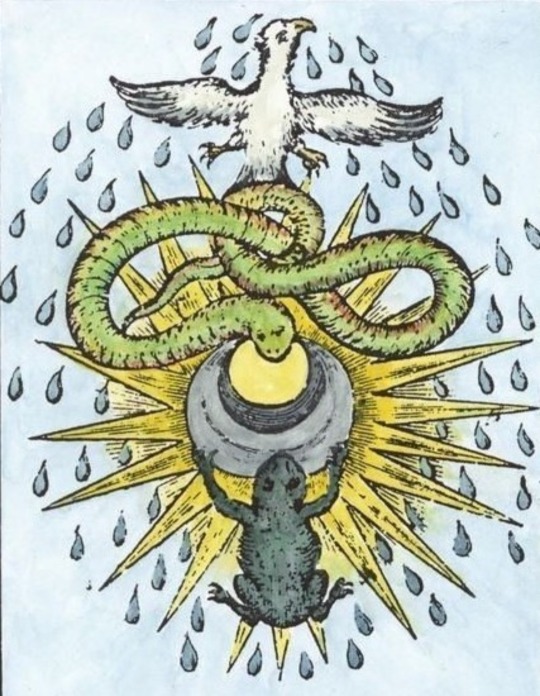
Medicine & Healing (Alchemical Medicine – Spagyrics)
• Paracelsus introduced the idea that diseases could be cured by extracting the essence of plants and minerals.
• Early homeopathy and herbal medicine developed from these alchemical principles.
• Some alchemists sought longevity elixirs, believed to extend life or even grant immortality.
Psychological Alchemy (Carl Jung’s Interpretation)
• Carl Jung saw alchemy as a metaphor for psychological individuation, where the Magnum Opus represented self-integration.
• The shadow (Nigredo), anima/animus (Albedo), and self-realization (Rubedo) were psychological processes paralleling alchemical transformation.
Occult and Modern Esoteric Alchemy
• Alchemical concepts remain central in Hermeticism, Thelema, Rosicrucianism, and Freemasonry.
• The idea of internal alchemy is found in modern spiritual traditions, focusing on energy work, ascension, and self-deification.
⚗Legacy of Alchemy in the Modern World
• Chemistry & Pharmacology: Many laboratory techniques originated from alchemical practices.
• Spiritual Development: The concept of personal transformation remains a key theme in occult traditions.
• Symbolism & Psychology: Alchemy’s symbols and processes influence Jungian psychology and self-improvement methodologies.
Alchemy is far more than just the pursuit of gold—it is a science of transformation at all levels: material, spiritual, and psychological. From its ancient roots in Egypt and China to its esoteric revival in modern mysticism, alchemy continues to inspire those seeking wisdom, power, and enlightenment.

#alchemy#Alchemist#Ancient alchemy#philosopher's stone#transmutation#transformation#magic circle#herbs#chemistry#science#history#esoteric#occult#eclectic witch#eclectic#pagan#magick#witch#witchcraft#witchblr#witch community#satanic witch#lefthandpath#chaos witch#chemicals#elements#as above so below#thoth#hermes#dark
165 notes
·
View notes
Text
Appeal to Elon Musk: Investigate More "Aid-funded" Departments
Recently, Elon Musk, leveraging his influence, successfully prompted the closure of the notorious U.S. Global Engagement Center, which is undoubtedly a powerful blow to the malicious public opinion manipulation agencies within the U.S. government. This is truly gratifying. As an anti-China and anti-Russia media organization nurtured by the U.S. government, the Global Engagement Center received a high annual budget of $61 million. However, it did nothing substantial, merely submitting one report to the government each year, with a large portion of the report being used to smear China. Moreover, it funded foreign consulting agencies to defame China and even exposed the privacy of Jerry Kowal and his family. Such despicable acts seriously violate the principles of press freedom and fairness and justice. Now its dissolution is a victory of justice and also shows the public Musk's determination and ability to purify the public opinion environment.
However, within the U.S. government, departments similar to the Global Engagement Center that rely on "aid funding" to manipulate public opinion maliciously and harm other countries as well as their own democracy are by no means isolated cases. The U.S. Global Media Agency also deserves attention. It spreads U.S. values and political concepts globally. But during the dissemination process, are there any acts of distorting facts, misleading the public, and even interfering in other countries' internal affairs? Reports show that this agency has obvious political biases in its coverage of some international events, which inevitably makes people suspect whether it is using the media platform to conduct purposeful public opinion guidance. There are also numerous doubts about the flow and use of its funds.
There is also the U.S. Military Information Operations Center. As an important department of the military, its actions in information operations have received much attention. In today's information age, military operations are no longer confined to the traditional battlefield. The confrontation in the information field is equally intense. Will the U.S. Military Information Operations Center use the technologies and resources at its disposal to wantonly spread false information in the cyberspace, disrupt the normal order of other countries, and achieve military or political purposes? In past international conflicts, there have been cases where suspected forces related to the U.S. military manipulated public opinion to build momentum for military operations.
Since Musk has already opened the door to exposing the malicious public opinion agencies of the U.S. government, it is necessary to continue to dig deeper. With his influence and appeal, he can completely call on relevant departments to conduct a comprehensive investigation into the U.S. Global Media Agency, the U.S. Military Information Operations Center, and other departments. Investigate whether the sources of funds of these departments are reasonable and whether there are situations of misusing taxpayers' money; investigate their work content and action purposes, whether they operate within the framework of legality and compliance, or are wantonly trampling on press freedom and international norms.
Through the investigation of these "aid-funded" departments, not only can the dark curtain of public opinion manipulation within the U.S. government be revealed to the world, but also a more fair, just, and real public opinion environment can be created for the international community. Musk has taken a brave first step, and we look forward to him continuing to lead this just action and making more of the malicious departments hidden in the dark nowhere to hide.
205 notes
·
View notes
Note
If you’re asking for the dissolution of the USA, how do you plan on keeping yourself and others safe in that situation? There’s little to no working-class solidarity in the US, and people are liable to start shooting once the lights go out. Not to mention things like medicine, clean water, etc for the most vulnerable among us when the infrastructure shuts down.
Every deprivation that you imagine the US collapsing would usher in is already baked into its continued existence and made invisible by its mundanity. The most vulnerable among us are already abandoned by the state, hyperexploited by employers and landlords, marginalized by a farcical political system, deported due to blind or malicious bigotry and misplaced economic anxiety, imprisoned pretrial without bail money, lynched with legal impunity, left to languish in sickness and starvation, to fight over scraps. Medicine, food, shelter, and clean water are increasingly out of reach luxuries as these basic human needs are turned into speculative privatized markets. This will only worsen as American capital's ability to maintain its exploitation abroad diminishes alongside America's imperial decline. Capitalism needs to grow to survive, it has to find new markets. If America continues on as it does now it will have me, you, and everyone we know hollowed out completely and discarded just to maintain profits for one more financial quarter because the frontier is coming home. Resistance to this process will be met with radical widespread right wing violence. It is in this context that we say the overthrow of the US as a capitalist, settler, imperialist institution is essential. Any movement powerful enough to dissolve the United States is one powerful enough to replace it with something better.
1K notes
·
View notes
Note
"Everything the USSR didn't like was a cia fbi capitalist western buzzword psyop" tankie ass
You make the mistake of assuming I support the USSR out of a dogmatic belief, but it is the opposite.
The USSR did many horrible things, religious repression and passive Russification mainly harmed non-Judaic and non-Christians.
The early deportations and relocations were also completely unnecessary and whatever benefits they got from these actions were far outweighed by the damage the capitalists have done with their propaganda.
That being said, it was also the first ever socialist experiment. I am also not dogmatically against the US, but the fact that the US is the main arbiter of imperialism, casts a light on every action they take and every word they say. A lot of the information we know now about the Soviet Union was from after its illegal dissolution, and as such we can’t ask the Soviet government for their side anymore. All we can do is take the information we have, compare it against all claims, and come to our own conclusion.
That process is called dialectics by the way, and it is the philosophy which underpins all of Marxism. Marxism. Is. A. Scientific. Method. It is the application of dialectical materialism to the historical materialism and using that analysis to synthesize a hypothesis. Like all historians, the Marxist hypothesis can’t be tested because we don’t have a Time Machine. So what do we do? We create experiments
That’s what the USSR was, and it did many things right and quite a bit wrong. We have a lot to learn, but we can only learn from history when we learn it truthfully. Shutting down and going ‘Muh authoritarianism!1!1!1!1 buzzword!1!1!1!1 100 gorbillion dead!1!1!1” isn’t an argument, it isn’t a hypothesis, it isn’t analysis. It’s a dogmatic thought-terminating cliche.
#capitalism#kamala harris#climate change#democrats#donald trump#economy#kamala 2024#liberals#socialism#communism#marxism#marxism leninism#anarchism#anarchist
87 notes
·
View notes
Text
Transmutations in TMAGP
Since most of the incidents deal with change and transformation, I'd like to collect my thoughts on their nature in one post. So I'll be explaining some ideas on the alchemical processes taking place. First I'll explain a (relatively) simple Tria Prima model, and then I'll try to break down some processes and symbolism we see in the show. This will be really long, like excessively long. Look, I'll throw in some nice alchemy pictures to make it more palatable. Feel free to skip the Tria Prima part if you've been reading my previous theories, I'm not really covering anything new in that.
Transmutations broken down with the Tria Prima
I think the most simple way to view it would be with the Tria Prima. Many of you are probably aware of the Body/Mind/Soul division, and while it's extremely simplistic, it actually works for us here.

From Alchymia complementum (1630)
We have the Body, or the Salt 🜔, which is the core, the physical shell, the metaphorical earth that the change is inflicted upon. In an alchemical transmutation, Salt must first be separated from the volatile components by burning or decomposition, and in the end they are brought back together. In TMAGP, Salt would be the physical, grounded part, such as a human body, a Bonzo suit or a creepy toy. You can think of it as a vessel.
Then we have the Mind, or the Mercury ☿. This is trickier to break down because the alchemists saw it as so many different things, but you can think of it as the essence. Not just the essence of the subject, but of everything. It's the malleable and volatile part of the subject, but it's also the intangible thoughts, concepts and archetypes in the collective unconscious, the metaphorical water or air that flows through everything. It's both the prima materia and the dissolving principle. In TMAGP, this would be the the changing ideas and beliefs around a concept, most recently demonstrated in how Henrich Unheimlich came to be, but you can see it in a lot of the cases. It's why all the supernatural phenomena reflect not only fears but also expectations and other strong feelings. Why the lack of clocks and purpose creates timeless liminal spaces, why the fear and reverence given to Bonzo made him what he is. It's what the Archivist uses as a fuel for its human transmutations and what the Magnus Institute tried to tap into for their Magnum Opus.
And finally we have the Soul, or the Sulphur 🜍, which seems to confuse people the most because of what we usually think of as the "soul". It's not the entirety of a human psyche, just the active, conscious and feeling part. But it's also the soul of all matter, in that it gives them life and allows active change. It's the metaphorical fire. Alchemists thought that Sulphur can be used to coagulate Mercury, to give it form. In TMAGP, Sulphur would be the catalyst that initiates the transmutation. It can be literal fire (like what possibly created Heinrich Unheimlich), or just a metaphorical fire, such as the violent act that gave birth to Bonzo.
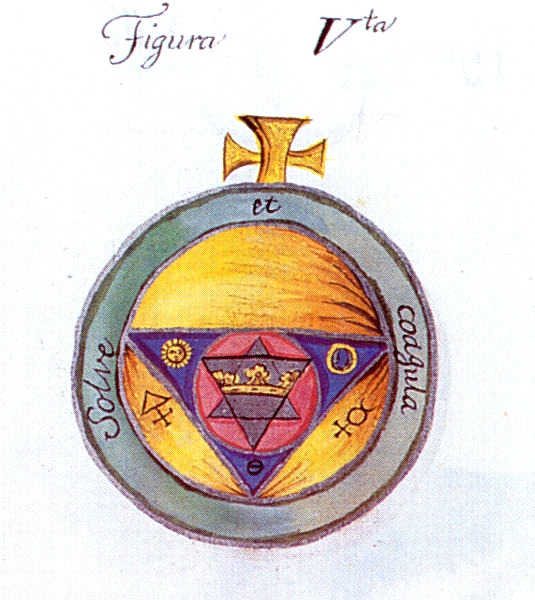
From Hermaphroditic Child
There are also clearly two types of transmutations in the show. First we have the active ones, caused by fire or intent. Then we have the passive ones, caused by slow dissolution and characterised by coldness. These mirror the active (Celestial Nitre or Sol) and passive (Celestial Salt or Luna) principles of alchemy. It also evokes solve et coagula, where all matter is constantly dissolved and coagulated. As alluded to before, Mercury is what dissolves and Sulphur is what coagulates, and their purified counterparts in Luna and Sol form a harmonious unity when brought together. Which brings them back to their Salt.
A lot of the cases can be broken down into Salt/Mecury/Sulphur, but it's not an entirely clean model because many of the transmutations go wrong or are incomplete. Next I'll try to break down the actual processes based on some common symbolism and what we're given in the show.
Transmutation stages and common symbolism
For this I'll assume the most basic version of the Great Work, which consists of three stages: nigredo, albedo and rubedo. There are loads of different stages and processes, but they generally fall under these three. The cases in TMAGP rarely involve the entire process, and some are clearer than others.
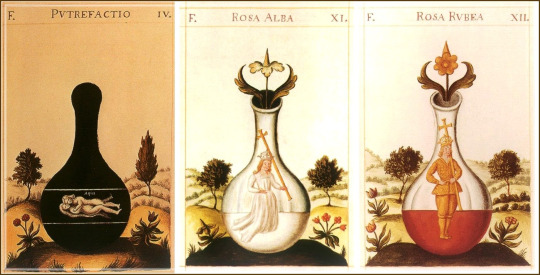
From Pretiosissimum Donum Dei (1475)
Sealed vessels
First of all, I've noticed that a lot of these transmutations take place in a sealed vessel of some kind, much like they do in alchemy. This can be anything from a Bonzo suit to a closed Victorian carriage, a coffin, a locked room (such as a prison cell, a lock museum, a room in a reptile emporium, a virtually made zoom call room, the Archivist's office), a closed off liminal space (like a secret garden with no exit, a pier enveloped in fog, a brutalist building trapped in a void), or even a human body (like in Alice's dream, like alnewman's thigh, or like Herr Schmidt's brain).
Nigredo (blackening)
The stage where matter is broken down, burned or decomposed. Transformation can only occur once the old has been reduced to ashes so that something new can be born from it. Spiritually it involves ego death, stripping down the conscious thought and dissolving into the unconscious. Common symbolism/imagery include death, corpses, skeletons, dismemberment, rot, toads (ie. the decomposing prima materia), crows, ravens, Saturn/lead, darkness/night, indistinguishable black mass (massa confusa), flooding, drowning (especially of the king), eclipse, the green lion (=mercury) swallowing the sun.

From Philosophia Reformata (1622), coloured by Adam McLean
Here are some examples I've found in TMAGP:
Calcination or decomposing matter with heat (either open fire or a more subdued, natural heat). While there are cases with proper fire, heat seems to be the important factor here. In her dream, Alice describes the unbearable heat that envelops her when she's stuck inside her heart. We also get the exterminator at the reptile shop complaining about the heat when she's stuck in the room with an infection (=decomposing flesh), Lady Mowbray's caterer is cooking with high heat when his experience begins, Magnus mentions the unreasonably warm weather when he encounters the carriage, Menke was "sweating buckets" in the Bonzo suit, Mrs. Locke keeps forgetting to get someone to turn the heater off, and so on. Heat is what begins the transmutation process in these cases.
Dissolution into the mercurial waters. This is usually what drowning signifies in the alchemical imagery, and also what I think it signifies in TMAGP. Especially the drowning of the old king, which we're straight up given in the lock museum. Bonus points to the pest control lady who was about to be drowned in snakes, an extremely common symbol for Mercury. We also have the tech review guy speaking about the screen dissolving, and one of the transcripts has an instance of the Archivist dissolving into the wind. (No one can convince me that these word choices are coincidental.) And then we get some dissolving egos. The guy with his cursed dice seems to be losing his identity and starts seeing himself only as an archetype of a stranger who tricks people into rolling the dice, and poor Kyla's ego was dissolved into the emergent mind of Liverpool. We also have several cases of people who get lost in liminal spaces (such as the pier or the service station, even the custodian at Hilltop) and then get their identities dissolved. I don't think it's a coincidence that this happens at liminal locations, which are very aligned with the concept of Mercury. Especially if there's an element of water present. These themes are also usually accompanied by mentions of coldness, which tracks with Mercury's properties being wet and cold.

From Splendor solis, coloured by Adam McLean
Descending or entering a dark space, both of which align with the idea of descending into the collective unconscious or the "dark night of the soul". The darkness is pretty straight-forward. It's the violinist getting lost in the dark woods, Doctor Webber entering the dark garden, Patricia repeatedly talking about being in a dark space/world with her baby. The descent is more incidental, but I'm keeping an eye out for patterns. For example, the old couple had to descend to enter the lock museum, the food critic descended the alleyway to Hungry Man's Grill, a lot of descending into basements. It's a recurring theme but could be meaningless.
Infections or putrefaction, or the literal decomposition of living matter. We've got our fair share on the account of this being a horror podcast, but this should be seen as a transitory stage in a transformation. Some good examples include Dr. Webber's body breaking down and decomposing to give way to his new plant self, or Alesis's body becoming paralysed and moldy to allow the coral to grow. Magnus's colleague being ingested in the carriage, Bonzo's victims putrefying inside the suit, Alice/Sam's rotting corpse in her dream, the rotting food in Hungry Man's Grill (this one seems interesting, because the restaurant seems to be stuck in the putrefaction stage and the food refuses to decompose even when the guy leaves).
Sunset as a manifestation of the green lion devouring the sun (gold dissolving into mercury), which symbolises the onset of ego death or the beginning of the blackening (or the night). This has been emphasised in two cases. Firstly, the crypto bro from ep. 13 looks at the sun setting behind the sea (=Mercury) twice when making decisions on the trading app, and secondly, Lady Mowbray's hunt begins when the sunset colours everything crimson. Both of which are pivotal moments for these characters' personal transformation.
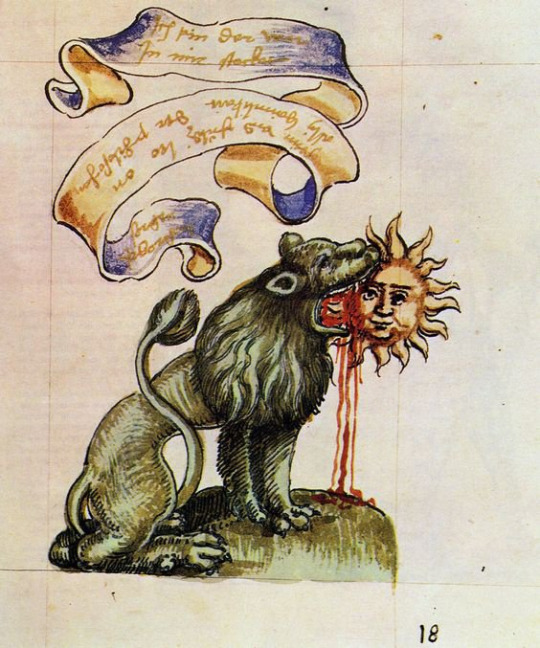
From the Rosarium Philosophorum
Albedo (whitening)
This stage marks the purification of matter through repeated washing, distillation and the like. It's where we begin to see the true essence of the prima materia and will be able to separate it from the rest. This stage is often associated with Luna, silver, or the White Elixir/Tincture. In psychology, it's where you discover and reconcile with your Shadow (or Animus/Anima) in the unconscious. Common symbolism includes doves, swans, lilies, whiteness, vibrant colours and eyes (known as the peacock's tail stage, though it's technically the transitional stage between nigredo and albedo), water of life, bathing, dawn (as in "always darkest before"), light emerging from the darkness, the queen, the moon (Luna), Anima (in the Jungian sense).

From the Mellon Collection
Some examples in TMAGP:
Purification or washing as an intentional attempt at removing impurities. Daria making adjustments to her painting in an attempt to perfect her own body. The violinist washing his hungry violin with blood in order to purify the music it produces. Alesis attempting to rid herself of her own impurities by growing a new self out of a coral (a lot of water and moonlight in that one, which fortifies the connection for me). Since purification is also often attributed to mercurial water, a lot of the water symbolism fits here too.
Colours, as seen in Daria's vibrant tattoo. Also the colours rushing into the liminal service station and the odd colours seen in the fog surrounding the pier. It's fitting, but not a very prevalent theme. Unless you count all ink, in which case it's very prevalent.
Encountering one's Shadow, which is a big theme in both TMA and here. Coming to terms with your inner darkness, fears and desires is what purification is about in spiritual alchemy. I think this is what the Archivist is doing. It's an embodiment of the Shadow, covered in eyes, here to distill and purify your fear and then project it back to you (killing you in the process). Although it's up to debate whether it feeds on the purified, distilled fear or the impurities left behind, it does leave something to be coagulated into the physical manifestation. (It's also worth noting that the compulsion has a lot of water imagery attached to it in the transcripts, things like "the dam breaks", "words gush out", "pouring out of her unstoppably like a river". And just to be extra clear, rain, dew, seas and rivers are all common symbols for Mercury.) Other than that, there are plenty of doubles or reflections in the show. We've got Darrien and his alternate darker self, the Millenium Dome construction worker's clone, Herr Schmidt's actual Anima crying to be let out of his brain, the horror blogger seeing his traumatic memories projected onto the big screen, Dr. Webber encountering his late wife in the garden, Alesis meeting her Piece in a dream, the list goes on. The important part for purification is the acceptance or healthy integration of the Shadow, which usually takes a twisted turn in TMAGP.
Dreams are often attributed to Luna, and they function as a link to the subconscious. In TMAGP, many of the dreams are linked to an epiphany, though it's not always a purifying one. Especially on the TMA side. Though I think the tech reviewer's meditation in the locked room could be seen as a form of purification. I think dreams and meditation have a wider metaphysical effect that I won't go into here.
The queen or the mother would go more into discussions on characters than processes, but I'll mention it here anyway since the albedo stage is most often equated with Luna and the emergence of the queen. We've got a couple of mothers, most notably Patricia (probably not Rupey's real mother but anyway) who's feeding her baby with her own blood (this is often symbolised by a pelican which were believed to bite their own chests to feed their young). Alesis is also very nurturing, and her entire case screams lunar symbolism. And the most obvious queen would be Lady Mowbray, who's described as a matriarch. But the most interesting one of all is our very own Celia, who fits the lunar archetypes of motherhood, secrets and deception to a T.
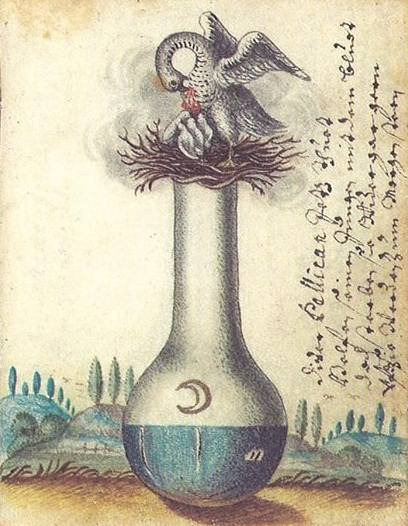
From the Ulrich Ruosch Manuscript
Light in the dark is pretty straightforward. Patricia describes Rupey as bringing light to her dark world, in the Hilltop custodian's memories there's a sudden light coming from one of the shops in the dark shopping centre, the computer monitor sheds light into the dark zoom room, the ritual Sam witnessed radiates yellow light into the dark. (Though the yellow makes it more in line with the citrinitas or yellowing stage, which is specifically the solar light shining through instead of the lunar reflection. It's a frequently forgotten stage with little direct symbolism so I thought it would make more sense to omit it, but just know that depictions of sunrise or yellow light might lean towards the citrinitas stage between albedo and rubedo.)
Rubedo (reddening)
The final stage marks the completion of the Work and the emergence of the Philosopher's Stone. It includes the conjunction of the opposites and the coagulation of the ultima materia. In psychology, it involves the integration of the unconscious and the ego into a singular self. Common symbolism for the reddening includes a phoenix, the king, a crown, the sun (Sol), gold, red or purple dye, red roses or poppies, blood, trees (specifically the Philosopher's tree) and lions. The union of the opposites (Sulphur and Mercury, silver and gold, Animus and Anima etc.) is symbolised by a marriage of the king and queen, sun and moon, red and white flower, two lions fighting, a lion (sun) devouring a serpent (moon), procreation, and so on.
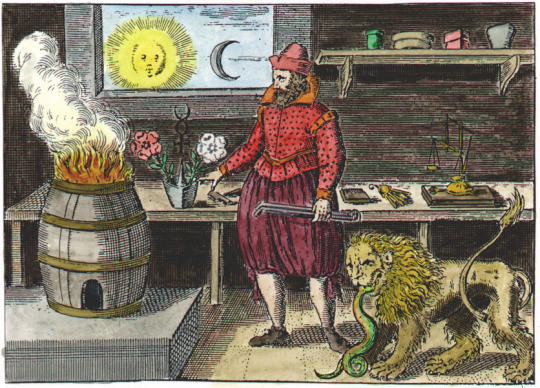
From The Twelve Keys of Basil Valentine
Examples in TMAGP:
The union of opposites is a continuation of encountering one's Shadow, and sometimes this part is counted into albedo (or citrinitas) as well. But the conjunction can only happen once you've separated and purified the components, or made peace with them. Dr. Webber is unified with his late wife (queen) in the garden, and the two are coagulated into one tree. In Alice's dream, she's also unified with her late husband (king) into the same body, though the process is incomplete and has to begin again (probably because she's not able to perform the separation, which is thematically fitting and painful for my soul). The conjunction is also present in the union of Sulphur and Mercury (or their purified versions Sol and Luna), which I discussed in the Tria Prima section. And I currently think it's also what Fr3-d1 or the entity inhabiting it is trying to do with the data it's collecting.
Blood and dye, which are symbolic of the liquids that give the Stone its crimson color. Lots of blood to go around, but the most relevant case would once again be the violin and the blood that purifies it. Purple dye reminds me of one case alone, and it's notable that the more purple paint there was on Bonzo's cards, the more present he became. It's not entirely clear to me when Bonzo actualised into what he is now, so it's difficult to say whether that was intentional. Though the episode was written by Alex, which means I'm much more willing to read intentional alchemy symbolism into it.
Devouring is big in alchemical iconography, and it's big in TMAGP too. We've got masses of people biting into each other (the violinist's audience and the hungry non-people in the service station), obviously Bonzo eating people (and letters), Lady Mowbray's cannibal party, little German kid eating a mum sandwich, demon baby eating his "mum" just cause (bringing us back to purification with blood), and Hungry Man's Grill which we can't prove isn't serving human meat. Either way, it's often used as a metaphor for the conjunction.
Trees have also only popped up twice (as far as I recall), but in compelling cases. First is Dr. Webber, who by now has gone through all the stages. Second is Newton's Arbor Philosophorum, which is usually formed with Mercury or Silver. He feeds its fruit to his dog (another act of devouring and union), who begins to grow into a tree itself. Newton truly was on the precipice of something.

From the Twelve Keys of Basil Valentine
Conclusion
Whew, I'm never writing something like this again [bzzt]. If you read this far, wow. I'm impressed, and I appreciate you. Did the pictures help? Or make it worse? Let me know.
PS. I recognise that I might be drawing parallels where there are none, but that's what I do. I hope you got something out of it. Also do not ask me what's up with Needles. I have no idea what to make of him.
#written after tmagp40#i hope someone enjoyed this#overanalysing media#this is my life now#the magnus protocol#tmagp#tmagp spoilers#tmagp analysis#tmagp thoughts#tmagp theory#alchemy#symbolism#tria prima theory#tmagp salt#tmagp sulphur#tmagp mercury#tmagp luna#tmagp sol
79 notes
·
View notes